Secrets of the Whales
Air Date: Week of May 7, 2021
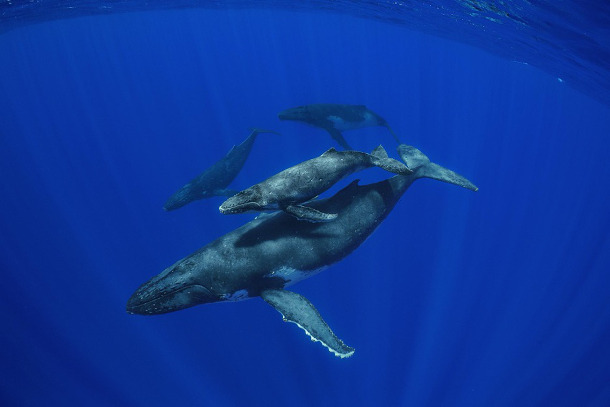
A mother Humpback Whale with her calf in the waters off of Rarotonga, Cook Islands along with two escort males. Humpbacks in this region spend summers feeding in Antarctica, then migrate to the South Pacific to places like the Cook Islands where they have their calves and spend time in the warm, protected waters here. (Photo: Brian Skerry)
On Earth Day 2021, National Geographic released Secrets of the Whales, a video documentary miniseries that seeks to unravel the secrets of whale behavior and understand whale cultures of orcas, humpbacks, narwhals, belugas, and sperm whales. National Geographic Explorer and wildlife photographer Brian Skerry joins Host Bobby Bascomb to talk about the experience of filming this epic project and the breathtaking complexity of whale societies across the world.
Transcript
BASCOMB: It’s Living on Earth I’m Bobby Bascomb
A new 4 part National Geographic video series, Secrets of the Whales, takes a deep dive into the culture of several whale species.
[HUMPBACK WHALE SONG]
BASCOMB: From the ever evolving song of humpback whales
[HUMPBACK WHALE SONG]
BASCOMB: To the unique way Orcas in Patagonia beach themselves to catch unsuspecting seals, or how narwhales know when to be silent to avoid predators in their migration. All of these are learned behaviors, some passed between individuals and many taught to young whales by their mothers. Brian Skerry is a National Geographic photojournalist. He spent 3 years filming the series and joins me now. Brian, welcome to Living on Earth.
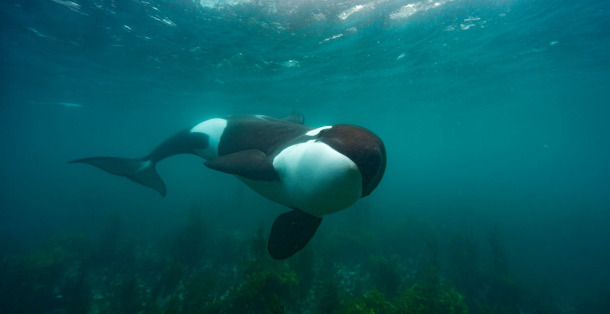
Orcas in New Zealand follow a unique hunting technique: taking stingrays off the bottom - sometimes in very shallow water. (Photo: National Geographic for Disney+/Kina Scollay)
SKERRY: Thank you so much, Bobby. It's a pleasure to be here.
BASCOMB: So, a theme that comes up again and again in this series is culture: that whales have distinct cultures. And not just between different species of whales, but between different pods or families. Broadly, how is culture expressed in whales?
SKERRY: Well, that is the essence of Secrets of the Whales. You're absolutely right. When I created this, I saw this as a game changer that the latest and greatest science was revealing that these charismatic ocean animals are showing behaviors that are really cultures, not unlike humans. My friend, Dr. Shane Gero, who's a sperm whale biologist, he defines it this way. He says behavior is what we do, culture is how we do it. So for example, most humans eat food with utensils, that would be behavior, but whether you use knives and forks or chopsticks, that is culture. So what we see in whales, you know, you might have a family of Orca that live in New Zealand, and their preference for ethnic food is stingrays. And they figured out how to eat those there. And the ones in the Norwegian Arctic, like to eat herring, and they figured out how to predate on herring. And the ones in Patagonia like seal pups, and they are the only ones in the world who have that strategy. They not only figured out this stuff, which is culture, but they pass it on to their children. So they are not only teaching their offspring the skills that they will need to survive, but they're teaching them their ancestral traditions, the things that matter to them. Whales have unique dialects. Sperm whales that Shane studies in the Eastern Caribbean, he's identified about 24 families that all speak the same dialect or language, and they belong to a clan. But they don't intermingle with other sperm whales that might come into those waters that speak another language. I think we can look at culture from a number of perspectives. But it's clear that like humans, they are doing things differently and what they know about their regions, their geographic location is unique to them. And that's what they celebrate.
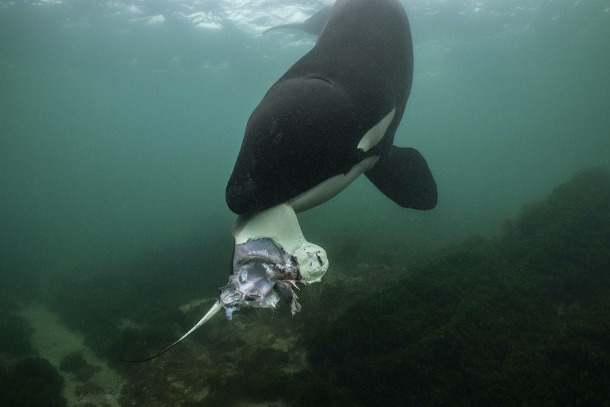
Orca hunting rays in the waters off of the North Island in New Zealand. (Photo: Brian Skerry)
BASCOMB: And during your time in New Zealand with orcas there, there was a moment in the series where you were invited to share in the spoils of their hunt. Can you tell us about that experience?
SKERRY: I can. This was certainly one of the most extraordinary moments of my career of four decades of exploring the ocean. We worked in 24 locations collectively for this series worldwide over three years. And I had just come from six weeks in the Canadian Arctic and I had about 10 days in New Zealand. I was working with a researcher Dr. Ingrid Visser, who is the orca expert, lives in New Zealand understands these animals. But again, you can never predict when something is going to happen. And we got lucky this one day we heard about this, we drove three hours to get there, got in the boat, went out found the orca, they were hunting in shallow water. I got in the water and started swimming towards them. And lo and behold, here is this adult female swimming towards me with a stingray actually hanging out of her mouth. My mind is on overload now, I'm thinking, I can't believe this. And then she drops it. So I'm thinking, oh man, you know, it's over.
She just gonna keep swimming. And I swim down to the bottom and I knelt on the sandy floor next to the dead stingray just laying there. And then out of the corner of my right eye, I see this orca coming back, and she swings behind my back, I lose sight of her for a moment. And then she emerges on the left side of my view, she swings around directly in front of me. And now we're staring at each other with a stingray between us. And she's looking at me and looking at the ray looking at me looking at the ray as if to say, "Well, are you going to eat that"? And when I don't go for it, then she very gently just bends over, picks it up in her mouth and lifts it up in front of me. And then she turns and begins sharing her food with another member of her family. You know, I don't think I fully processed what was occurring until after. That night over dinner, I started to think about just how remarkable that was. I talked recently with James Cameron about this. And he said, well you know, cultures do this. They share food. It's it's an offering. Very possibly that's what's going on. And you know, for me, I've had so many extraordinary moments with wildlife over the years. But this was right at the top of the list. It was really something very, very special.
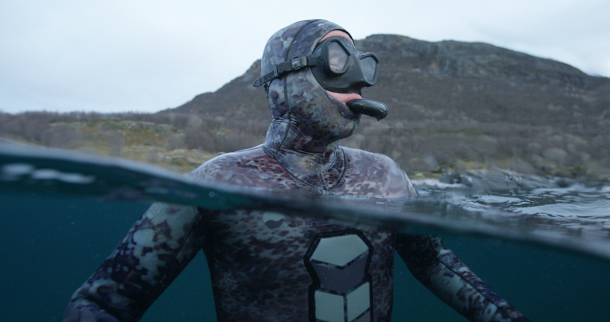
National Geographic photographer Brian Skerry travels to Norway's remote fjords for a chance to capture new orca behavior. (Photo: National Geographic for Disney+/Luis Lamar)
BASCOMB: Yeah. And there's a cameraman right there so the viewer can watch this whole scene and you're wearing a black wetsuit. And I gotta wonder, does the orca just think you look like a skinny whale who maybe need some help?
SKERRY: Maybe, I mean, it's very possible. Who's to say? These are animals that share food, that's what they do. They catch a ray and then they turn around and one will hold it in their teeth in their mouth and another one will come over and take a piece off. So you know, I mean, it's very possible she was thinking, come on, join in the feast with us.
BASCOMB: The second part of your series is about humpback whales and you focus a lot on the sophisticated ways that they have of communicating across really vast distances. The males make up a new song each year that can travel thousands of miles. Can you tell us more about that?
SKERRY: Yeah, I call it the "American Idol" of the sea. It's a bit of a singing competition where, as you described, these males will compete every year at the beginning of the year with a tune, and then one tune gets to be the winning tune. And they adopt it and everybody sings that same song, pretty much. They might add little bits and pieces here and there, but they essentially pass it across the entire ocean. It's been described in scientific papers as the horizontal transmission of culture. Now, the interesting thing is that it's always been believed that the humpback whale song sung by the males is something to do with mating, that they are attracting females the way that a bird would attract a mate with its song. And there very well may be truth to that. But I've talked to researchers who have spent decades studying the humpback whale song, and I asked them what percentage of the time do you actually see a female come over and pair up with a male? And I forget the exact number, but it was something like 0.001%. So it doesn't get seen that often.

Humpback whales undergo one of the longest migrations of any mammal on Earth - over 6,000 miles. (Photo: National Geographic for Disney+/Adam Geiger)
Now, might it be that the collective number of males that are singing in a given place are attracting the females to those waters, and then they can do their courtship and mating and so forth? Perhaps, but I wonder, they're creating these very lyrical, 20 minute-long songs, and to be in the water next to them and to hear it is awe inspiring. It resonates your body, and maybe a little mystical, but I wonder, is there other information encoded in that message? Might it be like an Aboriginal song line that they're including some cultural elements of that song? Is it purely just to attract a mate? Or are they weaving in stories of their ancestors? Maybe that's a little bridge too far. Maybe that's a limb that some scientists won't go out on. But the bottom line is, we've been studying these animals for decades, we don't fully understand. I think there's a lot more secrets out there that, you know, need to be revealed in the time ahead. So hopefully, we'll figure that out.
BASCOMB: Yeah, that's amazing. And you know, we've been talking about male humpback whales. But I have to say, I think the females are really just as amazing. Can you talk to us please about the sacrifice they make each year when they have a calf and and the tremendous journey that they make with their babies?
SKERRY: Absolutely. You know, humpback whale mom invests a great deal into her calf. It's a year-long gestation period. And then for the first year of that life, it is learning everything that it needs to know from mom, it is joined at the hip. There up nuzzling next to its chin, and going along next to its eye, and then nursing underneath. It's such a tender moment to go out in the morning and one of these tropical locations like the Cook Islands, or Tonga, go into a quiet little Cove and then slip in the water. And just at the edge of visibility, you see this tenderness, this absolute love that's being shared by the mom and calf. And then as you say, they have to make this epic journey. There's new science that's come out just maybe in the last year or so that reveals that humpback whale moms whisper to their babies when they're traveling through areas where predators might be so they don't give away their location. So again, I think there's just so much richness to these bonds, these relationships. And again, so much of that we don't fully understand as well.
BASCOMB: Yeah, I was really struck by the fact that the mothers will feed their babies something on the order of more than 100 gallons of milk each day without eating themselves, they go for months and months without eating and are still nursing the babies just a tremendous amount of milk. It's amazing.
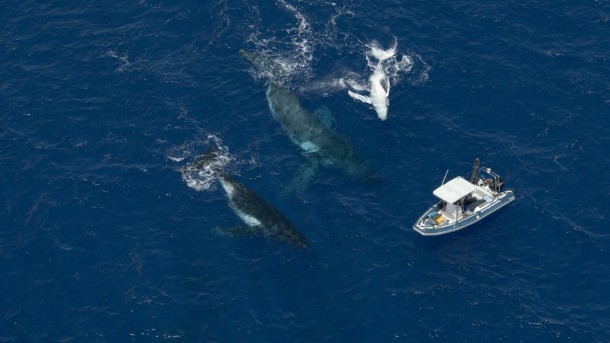
A group of humpbacks approach biologist Nan Hauser and National Geographic photographer Brian Skerry while on assignment for Planet of the Whales. (Photo: National Geographic for Disney+/Hayes Baxley)
SKERRY: It is, and that's how that calf grows. But think about the impact on that mom's body. I mean, the humpback baby is gaining weight every day, but she's losing it. So by the time it's ready to make that journey, she must be exhausted, you know, she doesn't have any energy. And now she has to make this epic migration to the feeding grounds and look after her calf and protect it from predators and all of those things. So you make a good point. She is deeply invested in that next generation. And it's it's a huge sacrifice, indeed.
BASCOMB: And you can see why they're obviously so invested. You know, we've heard stories of mothers losing their babies, they die for some reason or other, and pushing them through the water for just days and days, maybe even weeks, just unable to let go. You can see why after such an investment.
SKERRY: Of course, and we've captured that in the orca episode where in the Norwegian Arctic, it was Thanksgiving Day. You know, I've been working for National Geographic for almost 25 years and I travel eight or nine months a year but this was the first time I had been away from my own family on Thanksgiving Day. So I woke up that morning and I was thinking about my family at home eating turkey and celebrating and wishing I was home, but I got on the boat with my wetsuit and we went out and we saw this family of orca moving very purposely through one of the fjords. I was able to get in the water and see this funeral procession, this mom carrying it's dead baby and all the other members of the family sort of protecting the mom and calf and, you know, you see this grief, there's no other way to interpret that I think then mourning. And it was very emotional for me to be able to see that. But clearly, these animals have empathy and share grief and joy. And I think that's the message of Secrets of the Whales is that if we can see our planet, the ocean, through the lens of culture through the lens of these animals that have rich societies, then maybe we change our view of our connection to the natural world and maybe protect this beautiful planet on which we live.
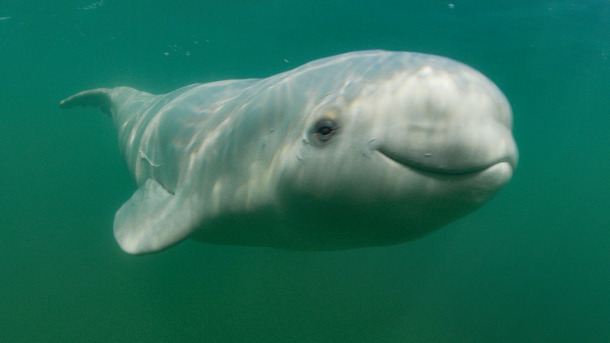
A baby beluga smiles at the camera. Belugas are the only whale that can use their lips to form different shapes to communicate. (Photo: National Geographic for Disney+/Peter Kragh)
BASCOMB: Gosh, I sure hope so. This series also documents the formation of a surprising cross species adoption between lost Narwhal, a youth, and a pod of beluga whales. What exactly happened there? And what does that tell us about the culture of whales?
SKERRY: Yeah, thats a really special situation. And these are two polar species that have some similarities. But generally, you're not seeing them in that kind of close proximity. I think that is quite unique. And I think it speaks to the empathy and the accepting nature of these beluga whale families. I mean, clearly, they know that that's not one of their own. But yet they saw this narwhal that was alone, and just made it part of the family. They adopted it as one of their own. And, I mean, how wonderful is that? I think this is one of the messages that I've taken away. You know, I spent three years working on this. As I've processed a lot of these moments that we witness in the series, it occurred to me that I've been reminded of things that I already knew, and that is that community matters, that family matters, that the whales make time for each other. A sperm whale for example, these are matrilineal societies led by the older, wiser females, they spend most of their life in the deep ocean foraging for squid. Life in the ocean is hard, but yet every day or every couple of days, they make time to come together and socialize. You see them rolling around and enjoying each other's company, reaffirming their family bonds. And for me to reflect back on this was to be reminded of how important social creatures are, that humans and whales can't do it alone. We need each other, we need family, we need community, and that that alone can bring us the greatest joy in life.

A narwhal's tusk is a long, hollow tooth that usually only develops in males. Its full function is still a mystery. (Photo: National Geographic for Disney+/Thomas Miller)
BASCOMB: It's a beautiful message. Well how important is it, do you think, to protect not just whale species, but whale cultures? So maybe some sperm whales in one place are doing okay, but if the resident pod and Dominica for example were to die out, what would be lost with them?
SKERRY: Well, that is a wonderful question and nobody has ever quite asked that. And I think it is immensely important. My friend, Dr. Shane Gero, who studies the sperm whales in Dominica, he wrote an op ed for the New York Times a few years ago, called the Loss of Whale Culture, and he specifically cited Dominican whales. He said that they are on a 3% annual decline because of anthropogenic stresses, they get entangled in fishing gear, they get hit by ships. And he argued that historically, biologists would look at that and say, you know, while tragic, it is not the end of the world because even if those whales go away, other sperm whales will come in and fill that niche. But what he says is no, what those whales know about those waters, the seamounts, the canyons, where the good food is, all the things that make them unique, would be lost. I think the loss of whale culture is an important aspect that gets lost in the bigger equation here, but in the way that we want to preserve human culture, we should want to preserve animal culture as well.
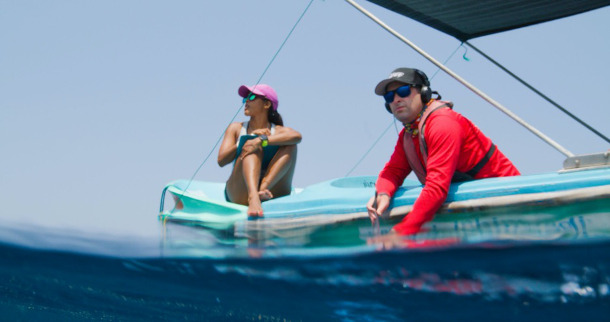
Marine biologists Shane Gero and Asha DeVos eavesdrop on sperm whale conversations with a hydrophone. They are listening for dialects that differentiate whale populations. (Photo: National Geographic for Disney+/Luis Lamar)
BASCOMB: It's really like our shared heritage.
SKERRY: It is, absolutely. You know, there's a great quote in my book from Henry Beston, in a book he wrote called the Outermost House about Cape Cod, and I won't get the quote, right, but he basically says that these other species that we share this planet with, they are not our underlings. They are not our brethren, necessarily. They are independent nations that we are traversing this journey on earth with, and therefore we must have equal respect.
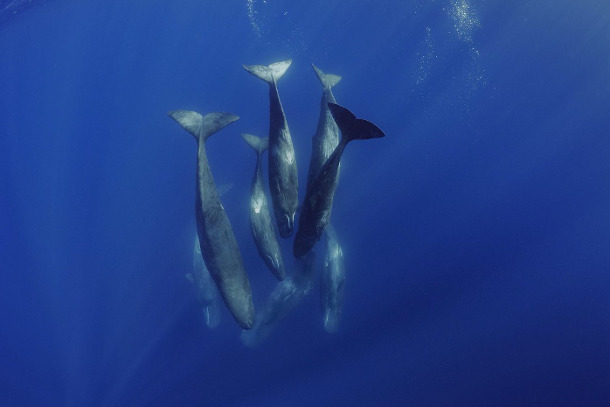
A family unit of Sperm Whales socializing underwater in the waters off of the island of Faial in the Azores. (Photo: Brian Skerry)
BASCOMB: What do you hope your audience takes away from this series? What's your goal here?
SKERRY: I guess my hope, on a very basic level is that everybody enjoys it that it's entertaining and that they're happy to learn something about whales. But if I could have a bigger wish, it would be that audiences begin to see our planet a little bit differently. If we can look at whales, and as a result the ocean, and as a result our planet through that lens of culture, understanding that these highly cognitive, sentient animals are living in the ocean, that they have rich ancestral traditions, they are doing things much the way that we do, that maybe we will see our planet and our connection to it in a different way. And that maybe we will change our detrimental behaviors to the planet as a result of that. So that would be my grander hope. And that maybe without overtly being about conservation, that it could change the way we do things.

Sperm whales prefer to hunt for squid far beneath the surface. They routinely stay an hour below and can explore as deep as 10,000 feet. (Photo: National Geographic for Disney+/Luis Lamar)
BASCOMB: Brian Skerry is a National Geographic explorer and marine wildlife photographer. Brian, thank you so much for taking this time with me and for this wonderful series.
SKERRY: Thank you so much, Bobby. It's a real pleasure.
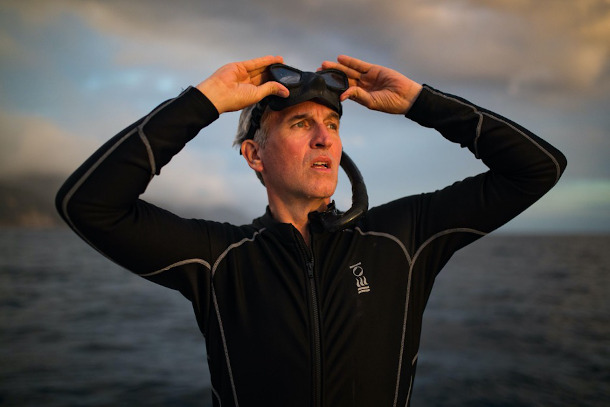
National Geographic Explorer and wildlife photographer Brian Skerry (Photo: Courtesy of Brian Skerry)
BASCOMB: By the way, to hear even more from Brian about the Secrets of the Whales you might consider listening to his free online lecture coming up on May 13, hosted by the New England Aquarium. For details visit the Living on Earth website, loe dot org.
Links
Stream Secrets of the Whales | Disney+
Brian Skerry’s official website
Living on Earth wants to hear from you!
Living on Earth
62 Calef Highway, Suite 212
Lee, NH 03861
Telephone: 617-287-4121
E-mail: comments@loe.org
Newsletter [Click here]
Donate to Living on Earth!
Living on Earth is an independent media program and relies entirely on contributions from listeners and institutions supporting public service. Please donate now to preserve an independent environmental voice.
NewsletterLiving on Earth offers a weekly delivery of the show's rundown to your mailbox. Sign up for our newsletter today!
 Sailors For The Sea: Be the change you want to sea.
Sailors For The Sea: Be the change you want to sea.
 The Grantham Foundation for the Protection of the Environment: Committed to protecting and improving the health of the global environment.
The Grantham Foundation for the Protection of the Environment: Committed to protecting and improving the health of the global environment.
 Contribute to Living on Earth and receive, as our gift to you, an archival print of one of Mark Seth Lender's extraordinary wildlife photographs. Follow the link to see Mark's current collection of photographs.
Contribute to Living on Earth and receive, as our gift to you, an archival print of one of Mark Seth Lender's extraordinary wildlife photographs. Follow the link to see Mark's current collection of photographs.
 Buy a signed copy of Mark Seth Lender's book Smeagull the Seagull & support Living on Earth
Buy a signed copy of Mark Seth Lender's book Smeagull the Seagull & support Living on Earth

